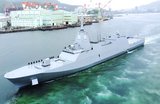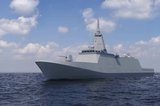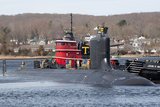JSOW C-1 integrated testing begins
Raytheon has announced that along with the US Navy, it has begun integrated testing (IT) of the company’s Joint Standoff Weapon (JSOW) C-1. The company made the announcement 21 August 2012.
During its first flight in IT, the JSOW C-1 was retargeted to strike a large moving ship target, to demonstrate that the JSOW C-1 can ‘receive third party target updates in-flight, retarget after release, and strike a precise point on a moving ship using the weapon's autonomous terminal seeker’.
According to Raytheon, the test presented two manoeuvring ships (large and small) as potential targets. Before weapon release, a navy F/A-18F Super Hornet targeted the smaller ship, and then handed off weapon control to a second Super Hornet also targeting the smaller ship. After release from the first Super Hornet, the JSOW C-1 was guided by the second Super Hornet toward the smaller manoeuvring ship target located 90 kilometres from launch point.
While in flight, the JSOW was retargeted by the second Super Hornet to the larger manoeuvring ship target. The JSOW provided weapon in-flight track and bomb hit indication status messages back to the controlling Super Hornet while successfully engaging the larger target ship. The test validated JSOW C-1's unique ability to be controlled, updated and retargeted as needed to eliminate its intended target.
JSOW is a family of air-to-ground weapons that employs an integrated GPS- inertial navigation system and terminal imaging infrared seeker. JSOW C-1 adds the two-way Strike Common Weapon Datalink to the combat-proven weapon, enabling moving maritime target capability, and is the first networked weapon with a range of approximately 100 kilometres.
Raytheon said the programme is on track to achieving initial operating capability in 2013.
More from Naval Warfare
-
![Future of the Canadian Patrol Submarine Project is still unclear]()
Future of the Canadian Patrol Submarine Project is still unclear
The Canadian government remains tight-lipped on the timeline and funding required for the next steps of its Canadian Submarine Patrol Project, which should offer improved capabilities for the country’s navy.
-
![Mitsubishi eyes future with Australia’s Mogami selection]()
Mitsubishi eyes future with Australia’s Mogami selection
With Australia’s selection of the Mogami-class for Project Sea 3000, Mitsubishi is investigating local production in the next decade as potential export opportunities emerge.
-
![Thales’ new Sonar 76Nano could equip UK Royal Navy on anti-submarine warfare missions]()
Thales’ new Sonar 76Nano could equip UK Royal Navy on anti-submarine warfare missions
The new sonar is designed to equip uncrewed underwater vessels, with the potential to be used by the Royal Navy for its Atlantic Bastion and Atlantic Net missions.
-
![UK to join US Navy’s Virginia-class submarine assembly effort to speed up construction]()
UK to join US Navy’s Virginia-class submarine assembly effort to speed up construction
The expansion of the Virginia-class submarine construction to UK shores could accelerate the project as US shipbuilders continue to fall short of delivery goals.























